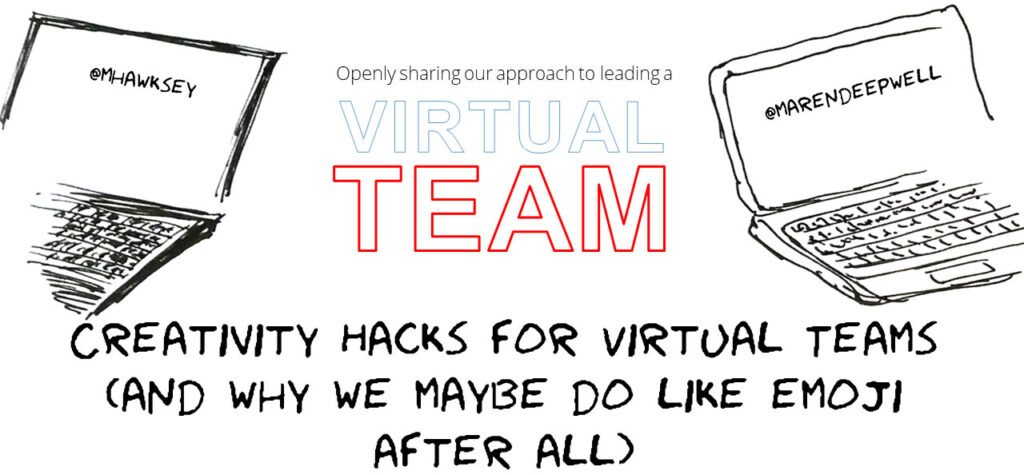
Hello and welcome to this month’s post on leading a virtual team. In this post (cross-posted here) the two of us, that is Martin Hawksey (@mhawksey) and Maren Deepwell (@marendeepwell), continue our series of openly sharing our approach to leadership.
If you are new here, you can catch up on earlier posts and podcasts or find out more about ALT, the organisation we work for as senior staff. We really appreciate comments and feedback and welcome questions or suggestions for future posts.
This time we get creative as we share our favourite ways to have some fun, create, collaborate and share. We also have another think about emoji.. which a year ago we gave a rather cold review.
July
Maren: When I started thinking about this post, I realised that creativity is a much bigger part of how we collaborate as a team than I initially thought. I’m excited about having some fun and sharing a few of my favourite ideas from the last year, starting with this example of an alternative team portrait:

We’ve made others, one with biscuits representing each member of the team particularly sticks in my mind, but this is definitely a favourite. A bag full of craft supplies, a table, an hour of chatting and making together and you have a fun, creative portrait. I much prefer this to posing for artfully smiley photos that end up on social media and the process of making the portrait together acts as a catalyst for conversation.
Another recent example of a bit of remixing fun as a team was creating our own Pet Top Trumps, featuring some of the four pawed companions we have as home workers:
One of the challenges of remote working is to find ways to interact with each other informally, to have some fun and that is particularly important when things are busy! Creating and sharing our Pet Top Trumps developed some new skills and really improved our spirits on a hot, long and busy summer day. These cards were remixed using the Fabulous Remixer Machine, which we also use in other creative ways.
Martin: Informal interaction is a really interesting point and thinking about it probably one of the toughest areas in a distributed team to get right. It’s quite easy to add informal conversations to the start/end of video calls but more challenging when catch-ups or team calls aren’t scheduled. It’s also probably easier to incorporate informal chat in one-to-ones because with our team meetings, particularly in Annual Conference prep mode, it feels like there is pressure that chatting might be delaying someone else from getting back to their to-do lists. In the past during busy periods we’ve also scheduled coffee breaks where we can hangout together. One of the challenges I find is when these have been purposefully set up they lose some of the spontaneity that you might get in a traditional office environment. Something I’ve found that works well is working with someone on a piece of work whilst in a video call with them. This could be a task like writing a piece of text together or working on some spreadsheet data. These moments are also useful for those serendipitous moments when you discover something new which might be a different way to do a task or just something you didn’t know about the other person. Within our team we also use a group text chat, which allows everyone to say hello in the morning and gives us opportunities similar to an office based chatting across the room. Currently we are using Google’s Classic Hangouts Chat for this which doesn’t have some of the additional features you get in the newer version, or other tools like Slack. Having used newer chat interfaces as part of other communities I’m part of I find my original dislike of emoji’s and reactions, which we talked about last year, slowly being eroded. I’ve yet to use these tools in the context of a virtual team and I can’t wait for Google to integrate the new Hangouts Chat into Gmail. When we talked about emoji almost a year ago you had similar hesitations for using these in a distributed team. Has your own view changed?

Maren: No. Yes. Maybe. My emoji literacy is still poor. I am one of those people who has to search for explanations of what ‘:s’ means… someone who having made her first ever Bitmoji promptly never made a second one. My icon vocabulary is rudimentary at best. I speak more Greek than emoji! That said, sometimes only a ‘:)’ will do, so I adjust how I express myself according to my audience. I value instant chat a lot for spontaneous interaction. Like you, I’m a year further into my experience using more ‘engaging, agile, responsive…’ chat interfaces. My feelings are still very mixed: I dislike that at times the volume of reactions/interactions can make the interaction meaningless, it becomes noise. I find the amount people have to actually engage or think about how they are reacting is minimal, which devalues the increase in interaction for me. I prefer someone not engaging to token reactions. I object to the notification push these interfaces try to dictate, i.e. ‘check who has liked your comment in the last hour…’. I don’t want to be notified in this way. And then there is context. Someone being silent can speak volumes and if they click the occasional ‘like’ I might miss their silence. So there are still a lot of downsides to the world of chat and emoji to me (and chatbots, for that matter). On the other hand, I love the playfulness, the fun, the sense of humour, creativity and flexibility these tools enable us to have. And that is really important in a team setting. I had an experience today discussing email, and a colleague pointed out a way in which we could save emails between us. The suggestion was prompted by them understanding how I work better, getting to know what’s important to me and why. A whole range of formal/informal communication led to that realisation, and to me, that’s what matters. Like drawing or walking or making something, I value things that get us thinking together.
Martin: In the case of reactions I can see a distinction between ‘likes’ in a personal setting compared to a professional context but at the same time, as we talked about in our last post, there is often a blur between social networks/chat in a work and personal life setting. I’ve only came across bitmoji recently and while I’ve seen others use them they are not something I’ve played with a great deal. Given the level of expression and potential outlet for creativity you get from some of the designer apps perhaps I should. Something that has put me off, particularly with the basic bitmoji you get with built-in virtual keyboards for Android, is the expression always seems a bit extreme for my mild mannered personality. While I’m becoming more inclined to emoji the next problem is given I’ve previously stated I dislike them in the past it feels more awkward to start using them purely because of my suborn streak. Given the reliance on online tools for virtual teams it’s perhaps worth remembering new tools get added, existing tools change in functionality and tools even get discontinued which means there is a degree of continual change with personal choices so having an organisational cultural alignment that supports this is important. In terms of creativity one of the aspects of my job I really enjoy is the opportunity to produce and collaborate on some of the artwork we use. This includes things like our Annual Conference splash screens to remixing some of the artwork and popup banners for the OER conference. Having recently bought a sticker machine I’ve been enjoying providing one-off creations.

Maren: Stickers are a great example of a creative outlet. I also came across this digital badge, which I made on a drawing app and using Google slides, as part of the team appraisal process a couple of years ago. Making one/off badges for individual staff is a quick, creative way to provide recognition and feedback with a twist. Another example of a creative approach to feedback is the ‘positivity by post’ exercise we did recently. That involved using a template to send each other feedback by post and that was really interesting in that it was a) positive feedback only, b) handwritten and c) delivered by post rather than email. For me personally changing the method of communication made the process both more creative and impactful. The final example I’d like to mention is clothing.. shoes, t-shirts, hoodies:
One for all the #altc #edtech runners out there.. 🙂 pic.twitter.com/rfu8fEuueu
— Dr Maren Deepwell (@MarenDeepwell) 26 July 2019